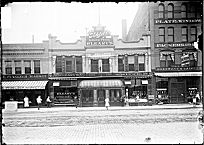| Entries |
| C |
|
Canaryville
|

|
Bibliography
Davis, Myron. “Canaryville.” University of Chicago Research Paper, doc. 1a, in “Documents: History of Bridgeport.” 1927. Chicago Historical Society.
Pacyga, Dominic A., and Ellen Skerrett.
Chicago, City of Neighborhoods: Histories and Tours.
1986.
Wade, Louise Carroll.
Chicago's Pride: The Stockyards, Packingtown, and the Environs in the Nineteenth Century.
1987.
The Electronic Encyclopedia of Chicago © 2005 Chicago Historical Society.
The Encyclopedia of Chicago © 2004 The Newberry Library. All Rights Reserved. Portions are copyrighted by other institutions and individuals. Additional information on copyright and permissions.
The Encyclopedia of Chicago © 2004 The Newberry Library. All Rights Reserved. Portions are copyrighted by other institutions and individuals. Additional information on copyright and permissions.